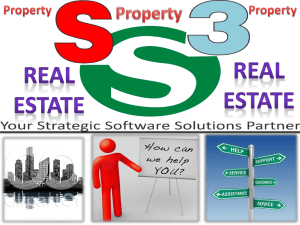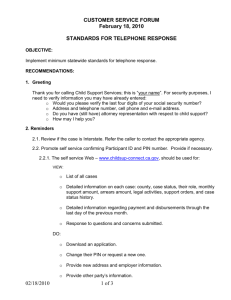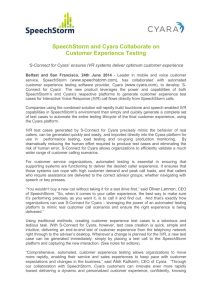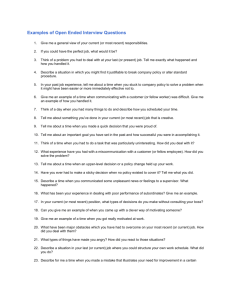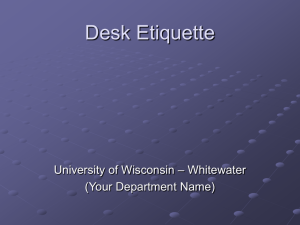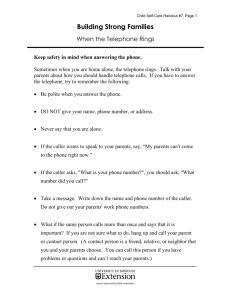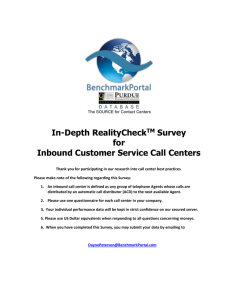BenchmarkPortal 12 KPI RealityCheck TM Survey For Inbound
advertisement
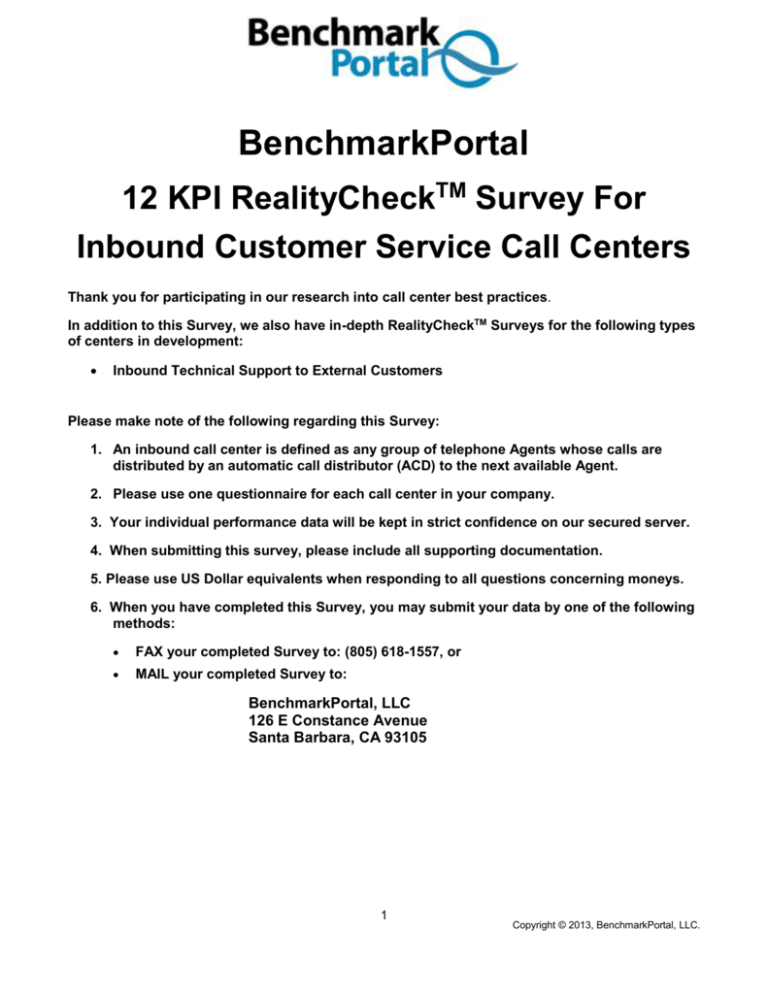
BenchmarkPortal 12 KPI RealityCheckTM Survey For Inbound Customer Service Call Centers Thank you for participating in our research into call center best practices. In addition to this Survey, we also have in-depth RealityCheckTM Surveys for the following types of centers in development: Inbound Technical Support to External Customers Please make note of the following regarding this Survey: 1. An inbound call center is defined as any group of telephone Agents whose calls are distributed by an automatic call distributor (ACD) to the next available Agent. 2. Please use one questionnaire for each call center in your company. 3. Your individual performance data will be kept in strict confidence on our secured server. 4. When submitting this survey, please include all supporting documentation. 5. Please use US Dollar equivalents when responding to all questions concerning moneys. 6. When you have completed this Survey, you may submit your data by one of the following methods: FAX your completed Survey to: (805) 618-1557, or MAIL your completed Survey to: BenchmarkPortal, LLC 126 E Constance Avenue Santa Barbara, CA 93105 1 Copyright © 2013, BenchmarkPortal, LLC. Participant Information (Please fill in completely) Name Title E-mail Address Company Name Mailing Address City State/Province Postal/Zip Code Country Phone Number Extension FAX Number Toll-Free Number of Your Call Center Referred by: If you have a problem completing your questionnaire, or you have any questions concerning benchmarking, please e-mail our survey team at: surveys@benchmarkportal.com Telephone us between 8 AM and 5 PM Pacific Time, Monday through Friday at: (800) 214-8929 ext. 2 From the Industry Groups Below, Please Circle One 2 Copyright © 2013, BenchmarkPortal, LLC. Industry that Best Represents Your Company 1. Catalog - Retail/Wholesale 2. Chemicals – Consumer / Industrial /Pharmaceutical 3. Computer - Hardware 4. Computer - Software 5. Consumer Products Consumables 6. Consumer Products - Durable Goods 7. Consumer Products - Electronics 8. Consumer Products - NonDurable Goods 9. Consumer Products – Other 10.Education 11.Financial Services - Annuity 12.Financial Services - Banking 13.Financial Services - Brokerage 14.Financial Services - Credit Card 15.Financial Services - Other 16.Freight - Rail/Trucking/Shipping 17.Government - Federal 18.Government – Local 19.Government: State/Provincial 20.Government – State: Soc. Svcs., Health & Welfare 21.Government - Service Providers 22.Government - Service Providers, Health Care 23.Health Care - Medical Equipment 24.Health Care - Provider/Hospitals 25.Health Care - Support Services 26.Immediate Response Services 27.Insurance - Health 28.Insurance - Life 29.Insurance - Other 30.Insurance - Property & Casualty 31.Level 1 Tech Support 32.Manufacturing Industrial/Construction 33.Manufacturing - Light 34.Manufacturing - Transportation 35.Media - Infomercial/Direct Marketing 36.Media – TV / ISP / Cable / Dish / Radio 37.Media – Publishing / Newspaper / Magazine 38.Not for Profit 39.Telecom - Cellular/Wireless 40.Telecom - Service/Landline 41.Telecom - Technology 42.Toll Operators 43.Transportation 44.Travel & Hospitality 45.Utilities - Energy Reseller 46.Utilities - Investor Owned (IOU) 47.Utilities – Municipal 48.Other Don't worry if you don't have the answers to ALL the questions. If you're not sure of an answer, give it your "best estimate" and then choose "estimate" on the items that aren't precise. 3 Copyright © 2013, BenchmarkPortal, LLC. 1 of 13. How many inbound calls per year are directed to your call center? Calls offered annually: (Calls offered is the total number of calls you receive in a given year. This number is provided by your ACD.) __________ ___ estimate? 2 of 13. Of all the calls handled annually by your center, how many are handled by each of the following two categories? In each area, please enter the appropriate number of calls handled. Annual call volume handled by your agents __________ ___ estimate? Annual call volume handled completely by your IVR __________ ___ estimate? (“Completely by your IVR” means that the call did not require a live Agent to complete the call and therefore, it was handled by caller “self service.”) __________ ___ estimate? 3 of 13. How many agents work at your call center? Full-time agents: (Fill in the number of full-time Agents employed in your call center.) Part-time agents __________ ___ estimate? (Fill in the number of part-time Agents employed in your call center.) __________ (An employee who is employed for an average of 20 hours per week or less) ___ estimate? 4 of 13. How do you compensate your agents? Average hourly starting wage for front-line agents. (Gross hourly wage) $ __________ ___ estimate? 5 of 13. Over the past 12 consecutive months, what were your average inbound performance timebased metrics? Average speed of answer (ASA) in seconds: (This is the total queue time, divided by the number of calls handled. This includes both IVR-handled calls as well as calls handled by a live Agent.) __________ ___ estimate? Average talk time (ATT) in minutes (includes hold time): 4 Copyright © 2013, BenchmarkPortal, LLC. (This is the average amount of time an Agent spends talking with a customer during the course of one phone call.) __________ ___ estimate? Average after call work time (ACWT) in minutes: (This is the average amount of time an Agent spends on performing follow-up work after the Agent has disconnected from the caller.) __________ ___ estimate? Average caller hold time in seconds while on the phone with an agent: (This is the average amount of time, in seconds, that a caller is on hold after being connected to an Agent. Most ACD systems provide this number.) __________ ___ estimate? 6 of 13. What is the average number of calls that an agent handles per hour? (This is the average number of calls that an Agent handles per hour.) __________ ___ estimate? 7 of 13. Over the past 12 consecutive months, what were your average inbound performance percentage-based metrics? Average abandoned in percent: (This is the percentage of calls that get connected to the ACD, but get disconnected by the caller before reaching an Agent, or before completing a process within the IVR.) __________ % ___ estimate? Agent occupancy in percent: (This is the percentage of time that an Agent is in their seat connected to the ACD, and either engaged in a call or available to answer a call. ) _________ % ___ estimate? Average calls transferred in percent: (This represents the percent of calls transferred from the original Agent that connects with the customer.) __________ % ___ estimate? 8 of 13. What is the annual percentage turnover of your full-time agents? (This includes promotional turnover and those leaving the center; however, should not include turnover incurred during new-hire training.) __________ % ___ estimate? 9 of 13. Does your call center have a formal process to collect the caller’s satisfaction regarding their experience with how their call was handled? ____ Yes ____ No 5 Copyright © 2013, BenchmarkPortal, LLC. 10 of 13. If your call center has a formal process to collect caller satisfaction (also known as caller feedback), what is the primary method you use to collect caller feedback on their call experience? ___ After call IVR surveys Customers routed into an IVR survey to share their feedback. ___ Follow-up outbound (live agent) calls Customers provide feedback to individual who has called them to survey them. ___ Follow-up email surveys Customers respond to email surveys to share their feedback. ___ Follow-up mail surveys Customers send in paper or postcard surveys with feedback. ___ Other 11 of 13. If "other", then please describe the method you use to collect caller satisfaction? _______________________________________________________________________________ ________________________________________________________________________________ 12 of 13. On average, in the past 90 days what percentage of your callers gave you a perfect score on the question, “Overall, how satisfied were you with the service you received during your call to our center?” (a “highest” score of 5 out of 5, or the top of whatever scale you use) Highly satisfied_______ % ___ estimate? 13 of 13. On average in the past 90 days, what percentage of your callers gave you the lowest score on the question, "Overall, how satisfied were you with the service you received during your call to our center?" (a “lowest” score of 1 out of 5, or the top of whatever scale you use) Highly dissatisfied_______ % ___ estimate? Thank you for participating in this survey. 6 Copyright © 2013, BenchmarkPortal, LLC. GLOSSARY OF TERMS FOR I NBOUND CENTERS A Abandon Rate: This is the percentage of calls that get connected to the ACD, but get disconnected by the caller before reaching an agent, or before completing a process within the IVR. The abandon rate is the percentage of calls that are abandoned compared to calls received. ACD: See Automatic Call Distributor Adherence to Schedule: A measure of whether agents are “on the job” as scheduled. This percentage represents how closely an agent adheres to his/her detailed work schedule as provided by the workforce management system. 100% adherence means that the agent was exactly where they were supposed to be at the time projected in their schedule. The scheduled time allows for meetings with the supervisor, education, plus answering customer phone calls. The question, “how often do agents deviate from their schedule” is answered by this metric. After Call Work Time: Call-related work that is done when an agent is not on a call. This is the cumulative sum amount of time agents spend on performing follow-up work after the agent has disconnected from the caller, divided by the total number of calls handled by agents. The data for after call work time is taken from the ACD and should be calculated by individual and group, daily, weekly, and monthly. Agent: A general term for someone who handles telephone calls in a call center. Other common names for the same job include, but are not limited to: operator, attendant, representative, customer service representative (CSR). Agent Development: A process designed to address the Agent’s individual needs, and to help them build their work skills, and achieve their career objectives. This may include, but be not limited to work behaviors expected, taught, measured and tracked, continuous education offered and encouraged, and career planning. Agent Satisfaction Measurement Process: A process designed to obtain feedback from all Agents, and aggregate this information into actionable reports that drive improvements in the call center that are Agent-centric. Agent Turnover: The number of agents who left their “agent job” (voluntarily and involuntarily) during the previous 12-month period, divided by the sum of agents working and hired during the same period, less those who left their job during the expressed period. The value is expressed as a percentage. The average number of agents working is calculated by taking the sum of the beginning year agent head-count plus the end of year agent head-count and dividing that sum by two. Do not include attrition during training. Annual Turnover % P 100 B RP Where: B = the total number of Agents working during the specified period; 7 Copyright © 2013, BenchmarkPortal, LLC. R = the number of new-hires during the specified period; and P = the number of Agents that left the center during the specified period. Analytics and Reporting Process: A process designed to provide a means to collect, store, and analyze call center performance data, and caller inquiry data. The visible products of this process are actionable reports for Agents, Supervisors, Mangers, and other departments in the company. As financial margins are often less, small centers are more subject to “bleed red” when not managed efficiently. When properly used, analytics and reporting enable managers to run the center as a corporate asset as opposed to a liability. Automatic Call Distributor (ACD): a device used to manage and distribute incoming calls to a specific group of terminals (agents). Automatic Number Identification (ANI): ANI is a service of telecommunications carriers, which identifies the telephone number of the calling party. It is commonly used for billing, call routing and database synchronization. There are several specific technologies that fit under the umbrella of ANI, including caller ID. Auxiliary (Aux) Time in Percent: This is the average amount of time per shift, in percent, that an agent is logged into an Aux state. When in an Auxiliary state, agents are not engaged in ACD work. Auxiliary time may include, but is not be limited to times for breaks, training, meetings, off-line work, etc. Although many Auxiliary states may become used, After Call Work Time is not a condition of Auxiliary Time and therefore it is inappropriate for Aux codes to be used as such. This should include all authorized off-line time, i.e., time set aside for handling e-mails, training, or other job-related tasks. Average Attendance in Percent: Actual number of shifts worked divided by the planned number of shifts times 100. This is a percentage representing how often an agent is NOT absent from work due to an unplanned absence (not to include excused absences, i.e., vacation, FMLA, jury duty, etc.). Take the total number of unexcused absences and divide it by the total number of absenteeism opportunities and subtract that number from 100. Average Cost per Call: This is the sum of all costs for running the call center for the period divided by the number of calls handled in the call center for the same period. This would include all calls for all reasons whether handled by an agent or technology, such as IVR. Average Handle Time: An internal metric that is the sum of talk time, hold time, and after call work time. Average Overall Processing Time: This is the sum total of agents time plus automated email response system time required to generate an email response divided by the total numbers of emails handled by a contact center within a 24 hour period of time.. Average Occupancy in Percent: This is the total staffed time logged in to the ACD (including ready/available, engaged on call, in ACW, in AUX, or other active states), divided by the total scheduled hours at work. Average Response Time: This is an average of the amount of time rounded to hours that elapse for a contact center to respond to an inbound email customer service message. 8 Copyright © 2013, BenchmarkPortal, LLC. Average Sale Value per Sale: When agents are taking orders, it becomes important to know the average sale value of individual sales. This number is determined by taking the total sales in dollars during a period of time, let’s say a week, and dividing this by the total number of sale calls handled during the same period of time. Average Speed of Answer (ASA): This is the cumulative total length of time of calls in queue or ringing before being answered by an agent, divided by the total numbers of calls answered. This includes both IVR-handled calls as well as calls handled by a live agent. Average Talk Time: This is the sum total of agents time in talk mode divided by the total numbers of calls handled by agents. Average Time in Queue: This is the cumulative total length of time of calls in queue before being answered by an agent. It is the time in wait time incurred by a call directed to a split/skill, which includes the time of wait during transfers. This is the average wait time that a caller endures waiting for an agent to answer the telephone after being placed in the queue by the ACD. This differs from average speed of answer because this calculation includes only calls that actually had a wait time. This metric is also known as average time of delay. Most ACD systems provide this number. Average Time to Abandonment: This is the average amount of time a customer will wait in queue before abandoning. B Base Salary per Year: This is the gross annual earnings of an agent as represented on their pay stub. Benchmarking: A structured, analytical methodology designed to establish a reference point on performance measures. The outcomes of this process enable practitioners to identify, assess, and deploy optimal practices to gain and maintain a competitive advantage. Best Practice: Best practice is the best performing metric in a category. Bottom Box Agent Satisfaction: The percentage of lowest possible scores received on the question, “Overall, how satisfied are you with your position?” (A “highest” score of 5 out of 5, or the top of whatever scale you use.) Bottom Box Caller Satisfaction: The percentage of lowest possible scores received on the question, “Overall, how satisfied were you with the service you received during your call to our center?” (A “highest” score of 5 out of 5, or the top of whatever scale you use.) Budget: The annual call center budget is the total annual dollar amount allocated for all expenses associated with the operation of the call center for which the call center manager is accountable. The annual budget should include all fully loaded direct and indirect costs for budgetary line items such as labor, benefits, and incentives for agents, management, training, and support personnel; HR costs (e.g., recruiting, screening, training); telephony expenses (toll, trunks, equipment); technology purchases/installation (hardware, and software); technology maintenance (hardware, and software) network; furniture, fixtures, decorations, etc.; utilities (gas, water, power, UPS backup); maintenance 9 Copyright © 2013, BenchmarkPortal, LLC. (repair, janitorial, upkeep); supplies; overhead expenses and charge-backs for shared corporate costs (e.g., legal, risk management, payroll administration, IT support, security, accounting, grounds keeping, real estate, floor space, common areas, etc.) as applicable.) Business to business: This is the percentage of calls exchanged with other businesses as opposed to end-user (private) callers. C Calculated Cost per Call in Dollars: The quotient of annual budget divided by annual calls handled (both IVR-handled and agent-handled calls). (Annual Budget / Annual Calls Handled) Calculated Cost per Call Minute in Dollars: The quotient of annual budget divided by annual calls handled (both IVR-handled and agent-handled calls), divided by average call handle time (the sum of talk time and after call work time). ((Annual Budget / Annual Calls Handled) / Average Handle Time) Calculated Calls per Full-Time Equivalent (FTE) in Dollars: The value derived from dividing the annual budget by total FTE’s*. (Annual Budget / Total FTEs) *See FTE Calculated Self Service in Percent: The value given from total number of annual calls handled by the IVR divided by the sum of all IVR-handled calls and agent-handled calls, expressed as a percent. ((Annual IVR Handled Calls) / (Annual IVR Handled Calls + Annual Agent Handled Calls) * 100) Call Center Performance Evaluation: This is a process designed to provide a visible means to manage the call center and report its accomplishments to upper management. Properly implemented, it defines those key performance indicators (KPIs) are optimal to manage the call center, determines the frequency to collect and analyze performance KPIs, and provides an understanding and guidance of how to manage (the center) if KPIs fall below goals. Call Recording: A technology that enables call centers to capture and record most customer/agent telephone interactions. See Call Quality Monitoring Process. Caller Satisfaction: This is a state of mind that a customer has about a company in which their expectations have been met or exceeded during their most recent interactions with the call center of the company. This leads to company loyalty and product repurchase. Caller Satisfaction Collection Process: An established routine process of gathering customer feedback regarding their recent calling experience, such as after-call IVR surveys, follow-up outbound (live agent) calls, follow-up e-mail surveys, etc. Caller Self-Service Process: This is a process designed to a) to have the caller input into the IVR as much information about themselves and the reason for their call to minimize live-Agent time, and b) to migrate low-value call to the IVR where the caller’s question can be answered by the IVR without talking to a live-agent. Caller Service Recovery: This process is designed ensure that follow-up to “disgruntled” callers is properly executed, their issues are understood, and where possible and reasonable, their issues are acted upon and resolved with a win-win solution. This process is different from that of Service Improvement in that it, Service Recovery, is designed to win back disgruntled or lost customers. 10 Copyright © 2013, BenchmarkPortal, LLC. Call Quality Monitoring: A process designed to observe and evaluate from 5 to 10 calls per month for each Agent, and to record the evaluations on a monitoring form to be discussed to the Agent by the Supervisor during the coaching process. Call Routing Process: This is a process designed to ensure that each call is routed to the next available Agent with the proper skills and training to handle the call in the most effective and efficient manner possible. Call routing often includes identifying “high-value callers” and routing them to a shorter queue. Calls Blocked: The total number of calls that did not connect with the ACD divided by the sum total number of calls offered plus blocked calls; shown as a percentage. These are calls that never make it to your ACD. Examples of blocked calls are: “busy signals,” “number not in service” messages, etc. This number is commonly furnished by the telecommunications provider. Calls Handled: These are the total number of unique inbound calls received in a given year by the center that are completed by a live agent, plus those completed by your IVR. The value for calls handled must be equal to, or less than calls offered, and should be approximate to the value of calls offered less those abandoned. This number is often provided by your ACD.) Calls Handled by Agent: These are the total number of unique inbound calls received in a given year by the center that are completed by a live agent. The sum of this value, when added to the sum of calls handled by the IVR, should equal the value for calls handled by the center. This number is often provided by your ACD.) Calls Handled by IVR: These are the total number of unique inbound calls received in a given year by the center that are completed by your IVR. The sum of this value, when added to the sum of calls handled by agents, should equal the value for calls handled by the center. This number is often provided by your ACD.) Calls Offered: This is the total number of inbound calls received in a given year by the center. This number is provided by your ACD.) Calls per Hour: The total number of calls handled per agent per shift divided by the total hours worked. Calls Resolved on First Call: This is the total numbers of calls that were completely resolved during the course of the first inbound call initiated by the customer (and therefore do not require a call back to resolve the issue) divided by total numbers of calls handled by agents – expressed as a percent. Also known as first call resolution (FCR) and first time final. Calls Transferred in Percent: The total number of calls transferred by agents (due to their inability to properly handle the call – for whatever reason), divided by the total number of unique calls handled by agents. This would not include voluntary transfers to other departments after resolution occurs for the initial call reason. Computer-Telephony Integration (CTI): refers to the technology that enables the coordination and integration of computer and telephone systems. Functions of CTI include: Calling Line Information 11 Copyright © 2013, BenchmarkPortal, LLC. Display, Screen Population (on call answer), On Screen Dial, Preview and Predictive Dial, & On Screen Call Control. Consumer to business: This is the percentage of calls exchanged with end-user (private) callers as opposed to calls from corporate callers or other businesses. Cost per Call: This is the sum of all costs for running the call center for the period divided by the number of calls handled in the call center for the same period. This would include all calls for all reasons whether handled by an agent or technology, such as IVR. You can also just calculate the cost per call for agent-handled calls. The number of calls received will be captured by the ACD. The total cost of the center can be obtained from your accounting department. Cost per Contact: a) Across all channels: This is the sum of all costs for running the call center for the period divided by the number of contacts handled in the call center for the same period for all contact channels, including phone (live agent and IVR), email, web-chat. b) By channel: This is the sum of all costs for running the call center for the period divided by the number of contacts handled in the call center for the same period for each contact channel, factored by its percentage of total contacts for all channels for the period, as follows: 1. Cost per Agent Handled phone contact = (Budget / # Agent Handled phone contacts) x (# Agent Handled phone contacts / total sum of all contacts) 2. Cost per IVR Self-Service contact = (Budget / # IVR Self-Service contacts) x (# IVR SelfService contacts / total sum of all contacts) 3. Cost per Email contact = (Budget / # Email contacts) x (# Email contacts / total sum of all contacts) 4. Cost per Web Chat contact = (Budget / # Web Chat contacts) x (# Web Chat contacts / total sum of all contacts) Cross-Sell: A cross-sell occurs when an agent recognizes that the caller might be able to use a product from the same company, but in a totally different product line within the company. For instance, an agent at a banking call center who is opening a savings account for a caller might recognize the advantage for the caller to purchase a CD from the bank at a higher interest rate. CTI: See Computer-Telephony Integration Customer Access Channels: Customer access channels are the multiple ways that customers can reach out and contact a company. A few of the obvious access channels are telephone, e-mail, fax, normal mail, kiosk, and face-to-face. Customer Centric: Placing the wants and needs of the customer as the central focus of all business practices within the firm. Seeing your business through the “eyes of the customer.” Customer Lifetime Value: The imputed dollar revenues or profits (depending on formula) generated by the customer for as long as the customer remains with the firm. 12 Copyright © 2013, BenchmarkPortal, LLC. Customer Relationship Management (CRM): This process is designed to ensure that the Agent taking a call is aware of all aspects of the caller’s information, including such things as purchasing history, previous contacts, credit rating, channel preferences, value to the company, and many more. The CRM process allows the Agent to use this caller information to better serve the caller’s needs during the call handling experience. Customer Retention: The process of keeping a customer as opposed to losing the customer to the competition. A percentage of this figure would be the tenure of the average customer with the firm as computed by the sum of the time of all customers with the firm divided by the number of customers. Customer Satisfaction: This is a state of mind that a customer has about a company in which their expectations have been met or exceeded over the lifetime of the product. This leads to company loyalty and product repurchase. Customer Share: The percent of those who purchase the item of interest from a given firm. This is computed as the number of customers who purchase the item from a given firm divided by the numbers of customers who purchase the item from all firms combined. Customer Value Segment: Customer value segmentation strives to segment customers based on their financial value to the company. This value is usually based on a combination of the total amount of money that a customer spends with the company, and the profitability of that revenue stream. The best example would be the frequent flyer programs that the airlines have. United, for instance, has the following value segments with its frequent flyer program: a) regular frequent flyer, b) premium frequent flyer, and c) 1K frequent flyer. D DNIS: Dialed Number Identification Service. A carrier service for 800/888 and 900 numbers that forwards the number dialed by the caller to the called party. E Effectiveness Index: The index is calculated by statistically combining into an index those metrics that are indicative of effective performance. This is considered to be quality and is impacted by customer-focused processes. Efficiency Index: The index is calculated by statistically combining into an index those metrics that are indicative of efficient performance. This is considered to be productivity and focuses on the cost of operating the business. External Metrics: These are usually characterized as “soft” numbers as they are the collected attitudes, opinions, and emotions of customers or other interested parties. The data may be collected by survey, focus group, or interview methods. This represents the customer perspective. F Focus Group: A personal, simultaneous interview among a small group of individuals. It depends more on group discussion than individual responses for the data generated. 13 Copyright © 2013, BenchmarkPortal, LLC. Full-time Agents: A full-time agent is considered as one who works 40 hours or more per week, or whatever equivalent used by your center. In some cases, full-time agents are counted at 36 hour per week. As this is an operational metric, the specific hours worked is less as important than the numbers of agents working in the capacity of a full-time agent. Full-time Equivalent (FTE): This is an operations and workforce metric that shows the amount of labor used in terms of full-time workforce. It is derived by adding the cumulative sum of labor hours for both full-time and part-time employees for a specified period and dividing its sum by 40. Total FTE’s = (total average hours of full-time agents + total average hours of part-time agents)/40 Example: Agent Type Agent Count Average Hours worked per week per agent Total worked hours Combined Workforce Hours Full-time 50 40 2000 Part-time 15 30 450 Totals 65 70 2450 2450 Standard Total Full-time FTE’s Equivalent Hours 40 61.25 H Help Desk: The term typically applied to an “internal” call center that handles primarily calls from employees about technical problems with their computer, monitor, printer, and the like. Hold Time: The cumulative sum total of all hold time, divided by the number of calls placed on hold for the period measured. I Information Access: An internal process designed to make all information needed by the Agent easily accessible on the Agent’s desktop for quick and accurate answers to caller’s questions. In theory, the Information Access process defines those access points used by agents to tap into the knowledge base management system (KBMS) of the company. Internal Metrics: These are generated by computers internal to call center technology (PBS, ACD, or VRU) or through departments such as Accounting, Finance, or Human Resources. Internal metrics are 14 Copyright © 2013, BenchmarkPortal, LLC. commonly perceived as “hard” numbers. Examples include average handle time, queue time, and abandon rate. This is generally not representing the view the customer has of your company. IVR: Interactive Voice Response. Technology that allows a customer making an inbound call to interact with the data systems by responding to a menu of options. Responses are typically entered by pressing the keys on the telephone keypad; however, voice recognition is becoming more commonly integrated into the process, thus providing a more useful tool. IVR Opt Out: Measure in percent, this is the number of callers who during their call to your center initially attempt finding solutions via the IVR, but then elect to speak with a live agent. This is not the same as those who choose to speak to a live agent as an initial menu option. L Labor Union: A legally recognized professional body organized for the purpose of supporting the needs of its members through the collective bargaining of wages, benefits, and working conditions. M Minutes of Telephone Usage: This is the annual number of minutes of telephone usage by the call center for calls. This does not include the phone usage for executive, administrative, and support personnel. This number is often provided by your telecommunications service provider (the phone company). Moment of Truth: MOT is a critical interaction between the customer and the product or service or employee that determines whether the customer will continue to purchase from the vendor. O Occupancy: See Average Occupancy in Percent Order Taking and Tracking: This is a specific function of customer service and it means that this call center specializes in just taking orders and tracking orders. Outbound Performance Metrics: These are all the measurements that indicate the performance of an outbound telephone agent. Examples might include calls/agent/shift or sales/agent/shift. Outsourcing: The process of contracting through a third-party, teleservices company to manage the call handling experience for a company that: a) doesn’t have the core competency to handle telephone call from its customers, and/or b) has too many calls to handle for its existing base of trained Agents. The third-party teleservices company typically specializes in call handling as their only core competency. P Part-time Agents: A Part-time agent is one who works a part-time schedule of less than 36 hours per week or whatever equivalent part-time cap is used by your center. In some cases, part-time agents are counted as agents that do not work more than 36 hour per week. As this is an operational metric, the 15 Copyright © 2013, BenchmarkPortal, LLC. specific hours worked is less as important than the numbers of agents working in the capacity of a part-time agent. Peer Group: Peer group does not necessarily connote competitors, but most often are the call centers that have the same profile of activities that you have. For instance, a peer group might be all call centers handling mostly inbound calls that are mostly business-to-business in a call center of over 100 agents for a company with annual revenues of over one billion dollars. Percent Abandoned: See Abandon Rate Percent Agent Utilization: Agent utilization is a calculated metric reflecting the percentage of an agent’s shift where the agent is logged into the system, engaged in active “telephone mode” which involves “talk time (ATT)”, “hold time (AHT)”, and “after-call-work time (ACWT).” Utilization equals the product of average call handle time (talk time + hold time + after call work time) and the average number of inbound calls per agent per shift (ACPS), divided by total time the agent is connected to the ACD and ready to handle calls during a shift, i.e., occupancy in minutes. Utilizatio n ( ATT ACW ACPS ) X 100 Occupancy _ in _ min . Percent Attendance: See Average Attendance in Percent Percent Blocked Calls: See Calls Blocked Percent Calls Handled on the First Call (aka, First Time Final): See Calls Resolved on First Call Percentage of Calls Placed in Queue: See Average Time in Queue Percentage of Calls Transferred: See Calls Transferred in Percent Public Business (or Branch) eXchange (PBX): a telephone switching device owned by a private company vs. one owned by a common carrier. Q Queue Time: See Average Time in Queue R Real-Time Expert Hub: A process designed is to enhance the probability that each call is completed on the first call. A Real-Time Expert Hub is often staffed by subject matter experts (SME) Rejection: The customer’s state of mind such that disengagement from the current relationship has already been decided and has been or soon will be implemented. Negative word of mouth is likely to occur. 16 Copyright © 2013, BenchmarkPortal, LLC. S Service Improvement: A process designed to use caller feedback from the call handling experience to improve how future calls are handled. Properly implemented, it involves conducting caller feedback surveys, documenting complaints, fixing the caller’s problem, and the process that caused the problems of the caller. Service Level: This is a broad-based term that is used to measure productivity; however, its use is not exclusive to the productivity of call handling. In contact centers it commonly defines X amounts of output in Y amounts of time. For example 80 percent of calls answered in 20 seconds. Skills-based Routing: A technology enabling the routing of calls to agents assigned a particular skill or set of skills. A common component of most ACD systems Span of Control (Agents to Supervisor Ratio): This is the total number of agents, including leads (if used) assigned to the control of each supervisor. Speech Recognition: A technology designed to use interpreted human speech that enables people to interact with a computerized (telephone) system Subject Matter Expert (SME): Specific to an organization, business unit, process, or item this is a designation provided to someone who demonstrates exceptional levels of expertise, knowledge, and abilities in the performance of a particular job-skill, task, or function related to the topic: a person that has an extended sense or in-depth knowledge of a particular subject. T Talk Time: See Average Talk Time Telephone Grade of Service (80% of calls answered in xx seconds): This is a productivity measurement of the average time in seconds it requires for the center to answer 80% of its calls offered. This differs from standard service level measurements that set a goal in time to which the center shall attempt to handle a prescribed volume of calls within. Use the following formula to calculate this value: Let X = your service level time; let Y = your service level percentage; S = the time in which 80% of calls are answered. S = (X * .80)/Y). For example, if you answer 93% of your calls in 20 seconds the results are as follows: S = (20 * .80)/.93 = 17.20 seconds.) Total Annual Budget: The annual dollar amount allocated for all of the expenses associated with the call center including (but not limited to): telecommunications expense, salaries, incentives, equipment, and supplies. See Budget Top Box Agent Satisfaction: The percentage of perfect scores received on the question, “Overall, how satisfied are you with your position?” (A “highest” score of 5 out of 5, or the top of whatever scale you use.) 17 Copyright © 2013, BenchmarkPortal, LLC. Top Box Caller Satisfaction: The percentage of perfect scores received on the question, “Overall, how satisfied were you with the service you received during your call to our center?” (A “highest” score of 5 out of 5, or the top of whatever scale you use.) Total Calls Offered: See Calls Offered. Touch-point: Touch-point is a “buzzword” for customer access channels. U Up Sell: To sell a higher value product to an existing customer. For example, to lease a more expensive copier to an existing customer. Also, see Cross Sell. Utilization: Utilization is the percentage of an agent’s shift where the agent is logged into the system and engaged in active “telephone mode” which involves “talk time (ATT)”, “hold time (AHT)”, and “after-call-work time (ACWT).” V Value-based Routing: A programmable form of Skills Based Routing targeted at Customer Value where customers are ranked in value and their calls are directed to designated agents. Value Creating Gap: This represents a performance gap where your call center is doing better than your peer group. Value Destroying Gap: This represents a performance gap where your call center is doing worse than your peer group. Voice Response Unit (VRU): See IVR. W Web Chat: An interactive keyboard messaging exchange between a customer / client / individual and a customer support representative (CSR) conducted over the company’s internet web site. Web Chat Session: This is the total elapsed time from the beginning to the conclusion of an interactive Web Chat exchange, expressed in minutes. Workforce Management: Related to Workforce Optimization, a technology often used for call forecasting and agent scheduling through historical call data. Other functions of workforce management may include skills-based scheduling, schedule adherence, time-off administrations, performance management tools and reporting Workforce Optimization: A process designed to ensure that the right Agent with the right skills is in the right seat at the right time to maximize the call center’s service levels with the fewest possible Agents. Wrap Up Time: See “after call work time.” 18 Copyright © 2013, BenchmarkPortal, LLC.
